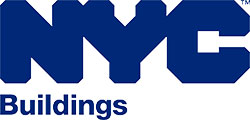
NYC DOB Chimney Codes (Local)
Oil Heat Chimney Codes
ANNUAL INSPECTION CODE:
NFPA 211.14.1 Annual Inspection
Chimneys, Fireplaces and vents shall be inspected at least once a year in accordance with the requirements of 15.1
CLEANING CODE:
NYC MC 801.18.2 Flue passageways
The flue gas passageway shall be free of obstructions and combustible deposits and shall be cleaned if previously used for venting a solid or liquid fuel-burning appliance or fireplace. The flue liner, chimney inner wall or vent inner-wall shall be continuous and shall be free of cracks, gaps, perforations or other damage or deterioration which would allow the escape of combustion products, including gases, moisture and creosote. Where an oil-fired appliance is connected to an existing masonry chimney, such chimney flue shall be repaired or relined in accordance with NFPA 31.
LINING CODE:
NYC MC 801.16 Flue lining
Masonry chimneys shall be lined. The lining material shall be compatible with the type of appliance connected, in accordance with the appliance listing and manufacturer’s installation instructions. Listed materials used as flue linings shall be installed in accordance with their listings and the manufacturer’s installation instructions.
NYC MC 801.16.1 Residential and low-heat appliances (general)
Flue lining systems for use with residential-type and low-heat appliances shall be limited to the following:
- Clay flue lining complying with the requirements of ASTM C 315 or equivalent. Clay flue lining shall be installed in accordance with the New York City Building Code.
- Listed chimney lining systems complying with UL 1777(new and existing chimneys) or ULC-S635 (existing chimneys) or ULC-S640 (new chimneys).
- Other approved materials that will resist, without cracking, softening or corrosion, flue gases and condensate at temperatures up to 1,800°F (982°C).
SMOKE TEST CODE:
NYC MC 810.3 Smoke test
To determine the tightness of chimney construction, a smoke test shall be made in accordance with the following conditions and requirements:
- The equipment, materials, power and labor necessary for such test shall be furnished by, and at the expense of, the owner or holder of the work permit.
- If the test shows any evidence of leakage or other defects, such defects shall be corrected in accordance with the requirements of this chapter, and the test shall be repeated until the results are satisfactory.
- The chimney shall be filled with a thick penetrating smoke produced by one or more smoke machines, or smoke bombs, or other equivalent method. As the smoke appears at the stack opening on the roof, such opening shall be tightly closed and a pressure equivalent to 1/2-inch (13 mm) column of water measured at the base of the stack, shall be applied. The test shall be applied for a length of time sufficient to permit the inspection of the chimney.
Gas Heat Chimney Codes
ANNUAL INSPECTION CODE:
NFPA 211.14.1 Annual Inspection
Chimneys, Fireplaces and vents shall be inspected at least once a year in accordance with the requirements of 15.1.
CLEANING CODE:
NYC FGC 501.15.2 Flue Passageways
The flue gas passageway shall be free of obstructions and combustible deposits and shall be cleaned if previously used for venting a solid or liquid fuel-burning appliance or fireplace. The flue liner, chimney inner wall or vent inner wall shall be continuous and shall be free of cracks, gaps, perforations or other damage or deterioration which would allow the escape of combustion products, including gases, moisture and creosote.
LINING CODE:
NYC FGC 503.5.6.1 Chimney Lining
Chimneys shall be lined in accordance with NFPA 211.
Exception: Where an existing chimney complies with Sections 503.5.6 (INSPECTION CODE) through 503.5.6.5 (SMOKE TEST CODE) and its sizing is in accordance with Section 503.5.5 (SIZING CODE), its continued use shall be allowed where the appliance vented by such chimney is replaced by an appliance of similar type, input rating and efficiency.
SMOKE TEST CODE:
NYC FGC 503.5.6.5.1 Requirement of a Smoke Test
To determine the tightness of chimney construction, a smoke test shall be made in accordance with the following conditions and requirements:
- The equipment, materials, power and labor necessary for such test shall be furnished by, and at the expense of, the owner or holder of the work permit.
- If the test shows any evidence of leakage or other defects, such defects shall be corrected in accordance with the requirement of this chapter and the test shall be repeated until the results are satisfactory.
- Method of test. The chimney shall be filled with a thick penetrating smoke produced by one or more smoke machines, or smoke bombs. or other equivalent method. As the smoke appears at the stack opening on the roof, such opening shall be tightly closed and a pressure equivalent to 1/2 inch (12.7 mm) column of water measured at the base of the stack, shall be applied. The test shall be applied for a length of time sufficient to permit the inspection of the chimney.
What Our Customers are Saying…
I am writing this letter to you to say thank you for the exceptional work that was done by Mike, to replace a chimney liner that was needed. I am very happy to say, that Mike was on time for my appointment today. I received a friendly and courteous response from him. Mike explained everything that was done and cleaned up very good.
I also thank Petro Oil for recommending you to me, and for the discount that was applied to my bill. I am completely satisfied with the work that was done in a very timely manner, and a big thank you to Mike.
Best of luck to you and your company. I would recommend you to my friends. Again, thanks for a job well done.
– Zena







